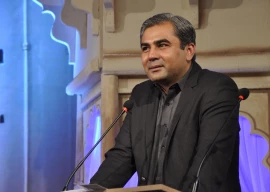
Why do we get so disappointed by someone who’s repeated these very antics for the past 16 years? Why do we get upset by the impulsive batting of someone who is now looking to establish himself as a serious bowler?
The answer may lie in the past.
There was a time when we were in our anonymous-troll stage of global politics. During this time, many of us would act in ways conforming to a common behavior pattern among both the young and the old in the dish-class. While everyone would intently be watching television (remember, this was still a time when the numerical buttons on the remote were an avenue into the rest of the world, which we viewed with awe and wonder), there was this inevitable moment when we would all be drawn in a little closer to the screen, completely spell-bound for 45 or so seconds, until someone would sigh and say, “Wese, yeh Indians ads barray zabardast banatay hain...”
Perhaps I am drawing this contrived analogy solely based on my own experience, but there can be no debate regarding the fact that Pakistan, at the time, was a pimply pre-teen desperate to get noticed.
Sure, we have ended up with a terrible reputation, but our repute has also got this notorious swagger to it. Back then we were a country that a villain’s sidekick in a bad action movie would mention as a place where you got smuggled goods from. Now, we have become a crisis for the Western world.
So at a time when Pakistanis desperately sought a place for themselves in the world, the quality of the Indian ads, and the innate ‘Indian-ness’ they so boldly conveyed, left us convinced that all Indian advertisements were bound by a common agenda to represent their country and their people as some new-age cultural hybrid superpower.
Of course, Pakistanis always knew that, in reality, Indians weren’t worth ****.
We would repeat this ad-nauseam, using complex theories which, depending on the civility of the conversation, ranged from ridiculing the hero worship of demigod Sachin Tendulkar and extolling the physical/mental/sexual benefits of eating meat to condescendingly talking of the ministers who travelled in old-fashioned Ambassadors.
But somehow, these ads still made us uncomfortable — conveying something that didn’t quite fit with our deprecating attitude towards the Indians. So we reasoned that those ‘chalaak’ Indians really knew how to sell themselves.
These were, after all, ads; their job was to sell.
Our ads of the time were simpler: we had ‘Farzana Davakhana’ and ‘Al-Rauf Model City’ (sung in the tune of Jaati Huun Mei) and, of course, ‘Gaey Soap’. For those of us who get these references, the ads are cultural artifacts, sources of nostalgia that we might cherish now. But as advertisements, they were mostly in the business of getting a lot of information across — or if slightly more sophisticated — get you to remember the brand.
In contrast, Indian ads were weaving tales of urban adjustment with rural tradition via electronic roti-makers, fashioning epics on the accomplishment of the petite bourgeoisie through two-toned wall paints, and dishing out dance-numbers celebrating gender empowerment and domestic bliss delivered by non-stick frying pans. Advertisements were creating elaborate fantasies, and those of us with disposable incomes longed to be part of it.
But over the years, the boom of Pakistani channels created more space for ads on the airwaves. The mindboggling growth of telcos and the easy-money days of the banking sector meant that there were more products that needed to be sold, and the old ways of marketing seemed redundant. Pakistani advertising finally came of age.
Today, Pakistani advertisers are picking up viral online videos and doing parodies on them, or making film-noir references for made-in-China mobile phones. They are pushing the envelope and daring to create fantasies for ideas and societies that don’t quite exist.
My favourite example of this is the raucous groups of youngsters who populate the mobile network ads. These groups manage to pull off the holy troika of Pakistani jawani: the perfect ratio of the number of guys and girls, dancing in groups with no awkward launda displays of homoeroticism, and set in places where there is no need to bribe the police or station guards. To live this kind of hormone-fuelled, hair-gelled existence is a bit too far-fetched in a place like Pakistan — making it a perfect fantasy to sell.
But to make the incredulous sell, no matter how far from reality it may be, is easy when a star is employed. That’s because a genuine star, a bona fide celebrity, is someone in whom we unabashedly invest our fantasies and desires. The conflation of our desires evoked by the product being advertised and those that we associate with the star leads to a desire nirvana — a perfect formula to sell.
Predictably, the one face you see the most in Pakistan selling products is Afridi’s. And that tells us something very intriguing about our national fantasies.
In just about every advertisement that features Afridi, whether it’s about skin whitening creams, motorcycles, bank accounts or chewing gum, the money shot — the moment when the use of the product is related to success — always shows ‘Boom Boom’ going for the big hit.
It seems to make sense, until you actually think about it. If we were drawn to these ads solely based on Lala’s looks (Afridi’s sexuality is dangerously transcendental), then we would gladly ogle at him for longer without needing to be lured by his batting.
If we were in it for cricket, then his persistent recklessness with the bat would put us off, or we would want snippets of video of his bowling action (that he is now much better at) and his typical celebration pose. Yet, even when his bowling and pose show up in an ad, they are invariably followed by a powerful knock over cow corner.
It’s not like the advertisers are closet Afridi fans, seeking to impose a fantastical version of his talent with the bat over the sobering reality of his pitiful performances with it. Let’s not forget, the advertisers only want their product to sell by associating it with something that is desirable.
Is it true then that despite the reams of columns written to savage him, and twitter streams calling for his head, and despite the burning effigies and the irate radio show calls — we really, really want Afridi to play just the way he does?
I’m sure you have a smug ‘no’ waiting for me. I don’t blame you — denial is the first recourse for all of us.
But if we didn’t want Boom Boom to start swinging the moment he walks out, why do our fantasies collude with his fabled hitting? I mean, if we really hated him batting the way he does, we would have formed a revulsion for these ads. But we haven’t.
Hence, it leads to the next question: why do we not? Why do we long to see a ‘Boom Boom Batting Blitzkrieg’ that is inherently risky?
I’ll try to answer this one without resorting to any meandering tangents, which means it doesn’t have a lot of nuance. I believe that we love the idea of everything big, be it a hit with the bat or the big innings coming off of it. Sure, our cricketing tradition boasts of many big hitters and we have historically revered our fantastic bowlers. But we specifically want Afridi to hit that big shot. We want to see someone so beautiful, so magnetic, and so utterly flawed and impulsive to have that one leap of faith come good. We want him to just go for the shot even when we know he’ll probably fail — because we know that if he does get it, and the one after that (and maybe a few more), all those times of misery and failure would have been worth suffering through.
Perhaps we are resigned to an absence of method, a lack of sophistication and a want for improvisation in our own lives. We know that despite our finely articulated programs for progress, we are just as useless as the ones we condemn. And we know that despite protestations to the contrary, we enjoy the idea of courage, of risk, and of rash impetuousness — if not in ourselves, then in someone we can invest our fantasies in.
Yes, we want the war to be owned and for the war to end, and yes, we want to get rid of corruption and understand patronage, and yes, we want to educate our daughters and honor our mothers, but ultimately, in our wildest fantasies, all we really want is for Afridi to hit another six.
Published in The Express Tribune, Sunday Magazine, November 25th, 2012.
Like Express Tribune Magazine on Facebook and follow at @ETribuneMag
COMMENTS (1)
Comments are moderated and generally will be posted if they are on-topic and not abusive.
For more information, please see our Comments FAQ














1710998259-0/pti-(1)1710998259-0-270x192.webp)


























too much psychoanalysis. also, we want afridi to hit the big hit, but not to get out. you do know that its possible? if others can do it, so can he, thats the thought. we dont want a suicide mission.